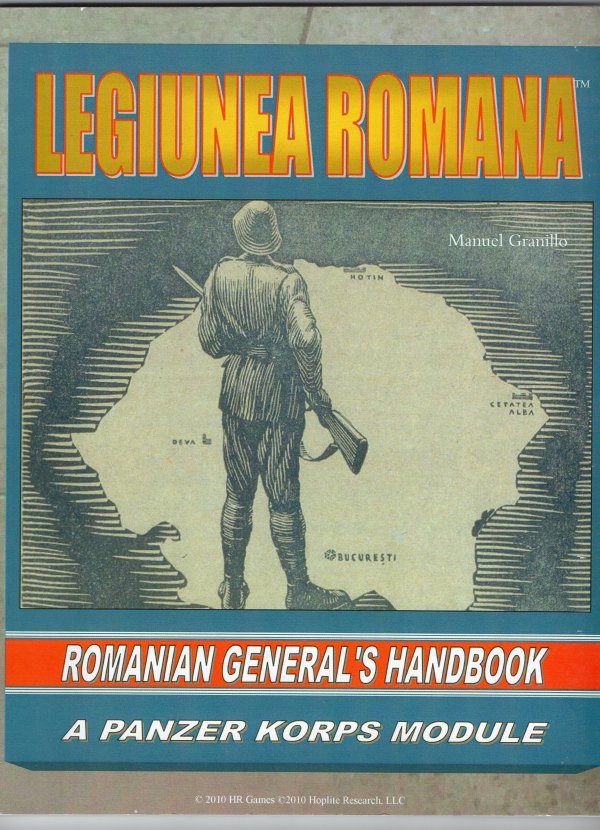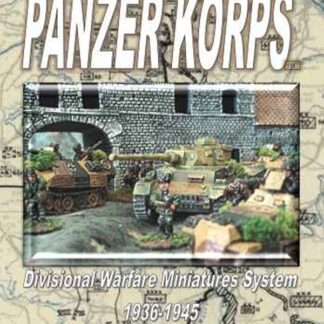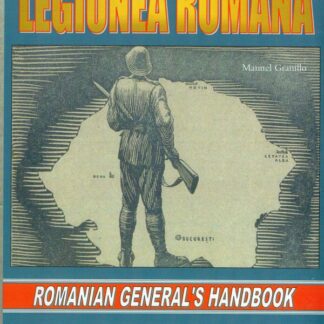Description
Panzer Korps – Legiunea Romana is the Romanian General’s Handbook for Panzer Korps. It covers all the Romanian formations from 1939 to the end of the war at the divisional level.
From Mountain Infantry to Cavalry brigades to when they were Soviet allies, Legiunea Romana covers all the vehicles, weapons and organizations you will need to play.
- Includes most major vehicles and organizations
- Detailed organization at the Divisional Level
- Glossary and specific Panzer Korps rules!
- Includes leaders, theater of operations and vital elements needed for Divisional Play.
The Principality of Romania 1859-1916
In 1859 Colonel Alexandru Ion Cuza became the common prince of Walachia and Moldavia and in 1861 the Turks recognized the uniting of the two states and the autonomous principality of Romania was born. Prince Alexandru had introduced many sweeping reforms that alienated both friends and foes alike.
Seven years after coming to power he was forced to abdicate. The provisional government elected Prince Karl Eitel Friedrich of Hohenzollern Sigmaringen, who took the name Carol I (Charles or Karl), was a member of the German Hohenzollern dynasty.
In 1877 a treaty between Russia and Romania was agreed to where in exchange for free passage through Romania by the Russian army, Russia would respect Romanian integrity.
In April 1877 Russia declared war on the Turks and began moving into Romania. In May 1877 Romania stopped paying it’s tribute to the Turks and declared its independence.
After the Russians had suffered heavy losses the Grand Duke of Russia, Nikolai Konstantinovich asked Prince Carol to join his military forces with the Russian Army.
Prince Carol led a combined Russo-Romanian army to victory at the battles of Grivita and Rahova. The citadel at Plevna fell after heavy fighting and forced the formal surrender of the Turkish General Osman Pasha.
Two more victories at Vidin and Smardan were earned by the Romanian army before the Ottoman Empire requested an armistice in January 1878. In March 1878 a peace treaty was signed by both Russia and the Ottoman Empire.
But the Russian promise to support the integrity of Romania was broken. In July 1878, 6 months after the armistice was signed the Independent principality of Romania was recognized by the Great Powers in return for supporting Russians against the Turks.
This did not come without a cost though, Romania had suffered over 10,000 casualties in the war and she had to cede Bessarabia (including Moldavia) to Russia and received in return Dobruja and access to the Black Sea.
Prince Carol was greatly discontented about the Russian occupation of Romanian territories and the betrayal by them in breaking the 1877 treaty. Prince Carol was persuaded by Bismark to accept the territorial loss on the grounds of potential economic gain with Romania’s newly acquired access to the Black Sea.
On March 26, 1881 the Principality was raised to a kingdom and Prince Carol became King Carol I of Romania.
The Kingdom of Romania 1881-1918 Balkan wars
Romania remained neutral during the First Balkan War against Turkey in 1912, but Romania joined Serbia and Greece in the Second Balkan War against Bulgaria in 1913.
Bulgaria was forced to cede southern Dobruja to Romania after the war. World War One Even though it is the largest Balkans nation Romania is surrounded by larger, more powerful neighbors and in international affairs it had no voice.
When WWI broke out, both alliances offer Romania territories for her support. The Central powers offer Bessarabia, and the Entente offered Transylvania.
But King Carol Declares Romania neutral. In October of 1914 King Carol I dies and is replaced by his nephew Ferdinand I. Romania stalls entering the WWI until 1916 and despite the friendly ties to Austria, joins the Entente and declares war on Austria-Hungary.
Within four month Romania two-thirds of the country is occupied by Austro-Hungarian, German, and Bulgarian armies and a majority of the Romanian army had been killed or captured.
In the summer of 1917 following the great battles of Marasti, Marasesti and Oitu Romania was able to hold the Central Powers in check. Romania negotiated a peace treaty with Germany in May 1918, but in October 1918 Romania again joined the war and as a rest of her contributions to the war effort she was allowed to unite with Bessarabia, Bukovina a Transylvania.
Both the Russian and Austrian-Hungarian empires had dissolved and Romania had emerged stronger.
Romania Mare (Great Romania 1918-1940)
As a result of her WWI spoils Romania nearly doubled its size and brought the L Romanian lands united under one rule with a population of 15.5+ million.
This gave birth to the Romanian expression “Romania Mare” (Great Romania) and fed the ideals of man nationalism.
This in turn provided support for the rise of nationalist, anti-Semitic such as the fascist native Iron Guard.
In 1925 the crown prince chose his mistress over his birth right and left Romania to live in exile. His son succeeded him to the throne in 1927.
In 1930 the exiled crown prince returned as King Carol II and the desperate economic conditions within Romania created a vacuum for the Iron Guard was filling with anti-Semitic propaganda.
King Carol succeeded in making himself dictator in 1938. During the 1930’s Romania’s isolated position forced her to look to Poland and France for military hardware and in 1939, Germany and the Soviet Union signed the Molotov-Ribbentrop Pact, in which Germany agreed to not interfere with Soviet “influence” in Bessarabia.
By June 22 1940 Romania was alone and isolated as both of her closest allies had fallen to the German Blitzkrieg The Germans and the Soviets took advantage of Romania’s feeble position and applied pressure on her, forcing her to give up territories.
The Soviets occupied Northern Bukovina and Bessarabia on June 28 1940, the Hungarians claimed Northern Transylvania on August 30 1940 and on September 7 1940 the Bulgarians took Southern Dobruja In a short span of 4 months Romania lost one third of its territory, Mare Romania was over.
The loss of these territories caused much dissatisfaction among the people. King Carol II was force to step down turn over the crown to his son Mihai I who in turn gave unlimited power to General Ion Antonescu the current Prime Minister.
Antonescu successfully with the support of the fascist Iron Guard formed a new government the National Legionary State; a shaky coalition between the military dictatorship and the Iron Guard.
Romania had oil and a long history of being on the short end of Soviet policy in the region, Hitler had the perfect situation for his planed invasion of the USSR. In November of 1940 Antonescu signed Tripartite Pact and Romania became an ally of Germany and not a victim.
In late January 1941 the Iron Guard tried to take control from Antonescu by force, the response was swift and Antonescu eliminated the Iron Guard.
Most of the Guard were either killed or imprisoned; those that fled to Germany were imprisoned by Hitler and kept in case Antonescu betrayed him.
There’s a dedicated Facebook group for Panzer Korps – Legiunea Romana.
To view the entire Wargaming Rules catalogue or the full Panzer Korps Rules and Supplements catalogue.







Reviews
There are no reviews yet.